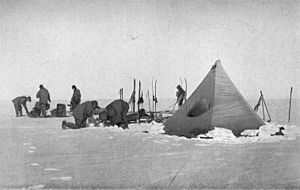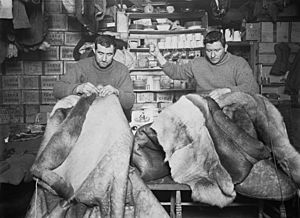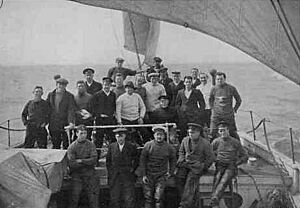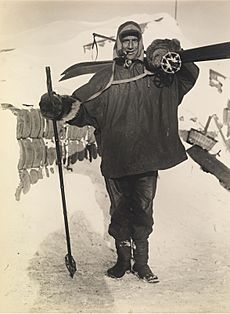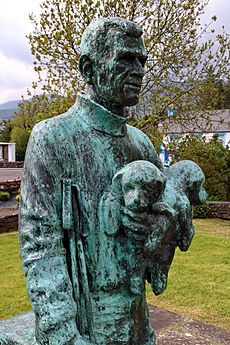Tom Crean (explorer) facts for kids
Quick facts for kids
Tom Crean
|
|
|---|---|

Crean on the Endurance Expedition, February 1915
|
|
| Native name |
Tomás Ó Cuirín
|
| Birth name | Thomas Crean |
| Born | 16 February 1877 Gurtuchrane, Annascaul, County Kerry, Ireland |
| Died | 27 July 1938 (aged 61) Bon Secours Hospital, Cork, Ireland |
| Buried |
Ballynacourty, Annascaul, County Kerry, Ireland
|
| Allegiance | United Kingdom of Great Britain and Ireland |
| Service/ |
Royal Navy |
| Years of service | 1893–1920 |
| Awards | Albert Medal (1913) Polar Medal (1904, 1913, 1916) |
| Spouse(s) | Ellen Herlihy |
| Children | Mary Crean O'Brien Kate Crean Eileen Crean |
| Signature | |
Thomas Crean (Irish: Tomás Ó Cuirín; born around 16 February 1877 – died 27 July 1938) was a brave Irish sailor and an amazing Antarctic explorer. He was even given the Albert Medal for Lifesaving for his courage.
Crean was part of three big trips to Antarctica during a time called the Heroic Age of Antarctic Exploration. This was when many explorers tried to reach the South Pole. One of his trips was with Robert Falcon Scott from 1911 to 1913. This expedition was a race to the South Pole, which was won by Roald Amundsen. Sadly, Scott and his team did not survive. During this trip, Crean walked alone for about 35 statute miles (56 km) across the ice. He did this to save the life of Edward Evans, which earned him the Albert Medal.
Tom Crean grew up on a farm near Annascaul in County Kerry, Ireland. When he was 16, he joined the Royal Navy. In 1901, while serving on a ship in New Zealand, he decided to join Scott's first trip to Antarctica, the Discovery Expedition. This was the start of his exciting life as an explorer.
After his experiences with Scott, Crean's third and final Antarctic adventure was with Ernest Shackleton. He was the second officer on Shackleton's Imperial Trans-Antarctic Expedition. Their ship, the Endurance, got stuck in thick ice and later sank. Crean and the crew spent 492 days drifting on the ice. Then, they used the ship's lifeboats to reach Elephant Island. Crean was part of a small group who sailed a lifeboat for 800 nautical miles (1,500 km) from Elephant Island to South Georgia Island. They did this to find help for the rest of the stranded team.
After retiring from the navy in 1920 due to health reasons, Crean opened a pub. He called it the South Pole Inn in County Kerry. He ran it with his wife and daughters. Tom Crean passed away in 1938.
Contents
Tom Crean was born around 16 February 1877. He grew up on a farm in Gurtuchrane, near Annascaul in County Kerry, Ireland. He was one of 11 children. He went to a local school but left at age 12 to help his family on the farm.
When he was 16, Crean joined the Royal Navy. He signed up at a naval station nearby. His first training was on a ship called Impregnable. He later served on several other ships, including Devastation and Wild Swan. By 1899, he had become a petty officer, second class.
In 1900, Crean was serving on the cruiser HMS Ringarooma in Australia. In December 1901, he faced a minor issue and was made an able seaman again. Around this time, the Ringarooma was helping Robert Falcon Scott's ship, Discovery. Scott's ship was in New Zealand, getting ready to go to Antarctica. When a sailor on Scott's ship left, a replacement was needed. Crean volunteered and was chosen. This was the beginning of his amazing journey as an Antarctic explorer.
Exploring Antarctica: The Discovery Expedition (1901–1904)
The Discovery ship sailed to Antarctica on 21 December 1901. Seven weeks later, on 8 February 1902, it arrived at McMurdo Sound. The crew set up their base at a place called "Hut Point". From here, they started their scientific and exploration trips.
Crean was very strong and good at pulling sledges. He spent 149 days pulling sledges, more than almost anyone else on the expedition. He was also known for his good sense of humor and was well-liked by everyone.
Crean went on several sledging trips across the Ross Ice Shelf. This area was then known as the "Great Ice Barrier". In October 1902, he was part of a team that set up supply stations. These stations were for Scott's main journey further south. On 11 November, Crean's team went further south than anyone before.
During the Antarctic winter of 1902, the Discovery ship got stuck in the ice. They tried to free it the next summer, but it was still stuck. Some members left on a rescue ship, but Crean and most of the team stayed. The ship was finally freed in February 1904. After returning to regular navy duty, Crean was promoted. This was thanks to Scott's recommendation.
Between Expeditions (1904–1910)
After the Discovery expedition, Crean went back to his regular navy duties. He served on several ships. Captain Scott had noticed Crean's great attitude and hard work. In 1906, Scott asked Crean to join him on his ship, Victorious. For the next few years, Crean continued to serve with Scott on different ships.
By 1907, Scott was planning his second trip to Antarctica. Around this time, Ernest Shackleton's expedition had almost reached the South Pole. Scott was with Crean when he heard the news. Scott told Crean, "I think we'd better have a shot next." This showed Scott's trust in Crean.
The Terra Nova Expedition (1910–1913)
Scott thought highly of Crean. So, Crean was one of the first people asked to join the Terra Nova Expedition. This trip set off for Antarctica in June 1910. Crean was one of the few people on the team who had explored the polar regions before.
In January 1911, the expedition arrived at McMurdo Sound. Crean was part of a team that set up "One Ton Depot." This was a supply station about 130 statute miles (210 km) from their base. It held a lot of food and equipment for the journey to the South Pole.
On their way back to base camp, Crean, Apsley Cherry-Garrard, and Henry "Birdie" Bowers had a scary experience. They were camping on ice that suddenly broke apart. The men were floating on an ice floe, separated from their sledges. Crean likely saved their lives. He jumped from one ice floe to another until he reached solid ice. He then called for help.
In November 1911, Crean joined Scott's team to try and reach the South Pole. This journey was very long and difficult. It involved crossing the Barrier, climbing the icy Beardmore Glacier, and then going all the way to the Pole. Along the way, some teams turned back to base. Crean was in the last group of eight men who went onto the polar plateau. They reached 87°32'S, which was only 168 statute miles (270 km) from the Pole.
On 4 January 1912, Scott chose his final team for the Pole. Crean, William Lashly, and Edward Evans were told to go back to base. Scott, Edgar Evans, Edward Wilson, Bowers, and Lawrence Oates continued to the Pole. Crean was very disappointed to turn back so close to their goal.
The journey back to base camp was about 700 statute miles (1,100 km). Soon after heading north, Crean's group got lost. They had to take a long detour around a huge icefall. With little food left, they decided to slide down the icefall on their sledge. The three men slid 2,000 feet (610 m), avoiding huge cracks in the ice. They somehow made it down safely.
They reached their supply station two days later. However, getting down the glacier was still very hard. Evans, who was guiding them, took off his goggles and got snow blindness. This made him unable to see properly.
Once they were off the glacier and on the flat ice, Evans started to get very ill. His joints swelled, and he was in great pain. Crean and Lashly worked hard to pull Evans on the sledge. They slowly made their way towards One Ton Depot. They reached it on 11 February. At this point, Evans collapsed. Crean thought he had died.
They still had over 100 statute miles (160 km) to go to reach the safety of Hut Point. Crean and Lashly continued to pull Evans on the sledge. On 18 February, they reached Corner Camp. This was still 35 statute miles (56 km) from Hut Point. They had only a day or two of food left.
They decided that Crean should go alone to get help. With only a little chocolate and three biscuits, and no tent or survival gear, Crean walked the 35 statute miles (56 km) to Hut Point in 18 hours. He arrived exhausted. He found Edward L Atkinson and a dog driver there. Crean reached safety just before a terrible snowstorm. This storm would likely have killed him. Atkinson led a successful rescue, and Lashly and Evans were brought back alive. Crean was very modest about his amazing feat. He wrote in a letter: "So it fell to my lot to do the 30 miles for help... Well, sir, I was very weak when I reached the hut."
Scott's party never returned. The winter of 1912 was sad, as everyone knew the polar party had died. In November 1912, Crean was part of the search team that found the bodies of Scott, Wilson, and Bowers. Crean later wrote that he had "lost a good friend."
On 12 February 1913, Crean and the rest of the Terra Nova crew arrived in New Zealand. In June, the ship returned to Cardiff. At Buckingham Palace, the surviving members of the expedition received Polar Medals from King George. Crean and Lashly were also given the Albert Medal, 2nd Class, for saving Evans's life. These were presented by the King on 26 July 1913. Crean was also promoted to chief petty officer.
The Endurance Expedition (1914–1917)
In 1914, Ernest Shackleton asked Crean to join his new expedition. Shackleton knew Crean well and trusted him completely. Crean joined Shackleton's Imperial Transantarctic Expedition on 25 May 1914. He was the second officer and had many jobs. He even took care of one of the dog teams and the puppies born during the trip.
On 19 January 1915, the expedition's ship, the Endurance, got stuck in the ice of the Weddell Sea. Crean almost got crushed by the moving ice. The ship drifted for months and finally sank on 21 November. Shackleton told the men they would drag their food, gear, and three lifeboats across the ice. They hoped to reach an island about 200 statute miles (320 km) away. But the ice was too rough, so they set up camp and waited. They hoped the ice would carry them to Paulet Island, where they knew there was a hut with supplies.
However, the ice carried them past Paulet Island. It did not break up until 9 April. The crew then had to sail and row the three lifeboats through the broken ice to Elephant Island. This trip took five days. Crean and Hubert Hudson guided their lifeboat.
Once they reached Elephant Island, Shackleton decided that one of the lifeboats should be made stronger. A small crew would then sail it to South Georgia to get help. The ship's carpenter, Harry McNish, led the work to fix one of the lifeboats, the James Caird.
Frank Wild, who was in charge of the men staying on Elephant Island, wanted Crean to stay with him. But Crean begged to be part of the six-man crew going on the boat journey. Shackleton agreed.
The boat journey to South Georgia was about 800 nautical miles (1,500 km). It is known as one of the most amazing sea journeys ever. It took 17 days through storms and snow. The navigator, Frank Worsley, said the waves were like "mountainous westerly swell." They set off on 24 April 1916 and reached South Georgia on 10 May 1916. Shackleton remembered Crean singing at the tiller. He said Crean "always sang when he was steering, and nobody ever discovered what the song was... but somehow it was cheerful."
They landed on the empty southern coast of South Georgia. The boat's rudder had broken. Shackleton, Crean, and Worsley decided to trek 30 statute miles (48 km) across the island's icy mountains. This was a dangerous 36-hour journey to the nearest whaling station.
This was the first time anyone had crossed the mountainous island. They had no tents, sleeping bags, or maps. Their only tools were a carpenter's adze, a rope, and screws from the James Caird hammered into their boots for grip. They arrived at the whaling station at Stromness. They were tired, dirty, and their faces were black from cooking with blubber. Worsley called them "the world's dirtiest men." They quickly arranged a boat to pick up the other three men. But it took Shackleton three months and four tries by ship to rescue the other 22 men still on Elephant Island.
Later Life and Legacy
After returning to Britain in November 1916, Crean went back to his navy duties. On 15 December 1916, he was promoted to warrant officer. This was to recognize his service on the Endurance. He also received his third Polar Medal. A month later, he got a license to sell alcohol from his home. He had bought this place in 1916. His family took care of the business while he was still in the Royal Navy.
On 5 September 1917, Crean married Ellen Herlihy. In early 1920, Shackleton planned another Antarctic trip. He invited Crean to join him. But by this time, Crean had a second daughter and planned to open his own business after leaving the navy. He turned down Shackleton's offer.
On his last navy job, Crean had a bad fall. This affected his eyesight. So, he retired from the navy on medical grounds on 24 March 1920. He and Ellen opened a small pub in Annascaul. He named it the South Pole Inn. They had three daughters: Mary, Kate, and Eileen. Sadly, Kate died when she was four years old.
Tom Crean was a very modest man. When he returned home, he put all his medals away. He never talked about his adventures in Antarctica. There are no records of him giving interviews to the press. His daughter Eileen said: "He put his medals and his sword in a box... and that was that. He was a very humble man."
During a difficult time in Ireland, his pub was once raided. But when the raiders saw Crean's photo in his navy uniform with his medals, they left his pub alone.
Crean's older brother, Cornelius, was a police sergeant. He was killed during a conflict in Ireland on 25 April 1920.
In 1938, Crean became very ill. He was taken to a hospital in Tralee. Since no surgeon was available there, he was moved to a hospital in Cork. He had an operation, but an infection developed. After a week, he sadly passed away on 27 July 1938. He was buried in his family's tomb in County Kerry.
Legacy
- Mount Crean is a mountain 8,630 feet (2,630 m) tall in Antarctica, named after him.
- Crean Glacier is a glacier on South Georgia, also named in his honor.
- A TV show called The Last Place on Earth told the story of Scott's expedition. An Irish actor played Tom Crean.
- A play called Tom Crean – Antarctic Explorer has been performed many times since 2001. It was even shown at his pub, the South Pole Inn.
- In July 2003, a bronze statue of Crean was put up across from his pub in Annascaul. It shows him with hiking poles and two sled dog puppies.
- The Dingle Brewing Company makes a "Tom Crean Lager" beer, named after him.
See also
 In Spanish: Thomas Crean para niños
In Spanish: Thomas Crean para niños



